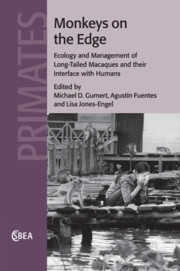Book contents
- Frontmatter
- Contents
- List of contributors
- Foreword
- Preface
- Acknowledgements
- Part I The status and distribution of long-tailed macaques
- Part II The human–macaque interface
- 4 Campus monkeys of Universiti Kebangsaan Malaysia: Nuisance problems and students' perceptions
- 5 Human impact on long-tailed macaques in Thailand
- 6 Macaque behavior at the human–monkey interface: The activity and demography of semi-free-ranging Macaca fascicularis at Padangtegal, Bali, Indonesia
- 7 The role of Macaca fascicularis in infectious agent transmission
- Part III Ethnophoresy of long-tailed macaques
- Part IV Comparisons with rhesus macaques
- Part V Understanding and managing the human–macaque interface
- Index
- References
5 - Human impact on long-tailed macaques in Thailand
from Part II - The human–macaque interface
Published online by Cambridge University Press: 16 May 2011
- Frontmatter
- Contents
- List of contributors
- Foreword
- Preface
- Acknowledgements
- Part I The status and distribution of long-tailed macaques
- Part II The human–macaque interface
- 4 Campus monkeys of Universiti Kebangsaan Malaysia: Nuisance problems and students' perceptions
- 5 Human impact on long-tailed macaques in Thailand
- 6 Macaque behavior at the human–monkey interface: The activity and demography of semi-free-ranging Macaca fascicularis at Padangtegal, Bali, Indonesia
- 7 The role of Macaca fascicularis in infectious agent transmission
- Part III Ethnophoresy of long-tailed macaques
- Part IV Comparisons with rhesus macaques
- Part V Understanding and managing the human–macaque interface
- Index
- References
Summary
Introduction
Long-tailed macaques (Macaca fascicularis) are the most frequently seen species among the thirteen species of primates in Thailand (Lekagul and McNeely, 1988, Malaivijitnond et al., 2005) and they were recently reported at 91 locations (Malaivijitnond et al., 2009). In comparison, only nineteen, twelve, eleven, and nine locations were observed for rhesus (M. mulatta), pig-tailed (M. nemestrina), stump-tailed (M. arctoides) and Assamese macaques (M. assamensis) respectively (Malaivijitnond et al., 2009). Long-tailed macaques inhabit a wide variety of habitats, including primary lowland rainforests, disturbed and secondary rainforests, riverine forests, and coastal forests of nipa palm and mangrove. They have been frequently seen on the forest periphery, and at recreation parks, tourist attraction sites, temples, and other areas nearby human settlements (Aggimarangsee, 1992; Fooden, 1995; Malaivijitnond and Hamada, 2008). This reflects their wide adaptability to various ecological conditions. Humans are continually invading and disturbing the natural habitats of long-tailed macaques, by means of deforestation, conversion to agricultural land, development of infrastructure and widespread encroachment. As a result, natural habitats are being increasingly fragmented, degraded, and changed by human activity. Long-tailed macaque populations have been isolated from each other and the risk of inbreeding and/or outbreeding depression has increased (Malaivijitnond and Hamada, 2008). Additionally, anthropogenic habitat alteration has increased the overlap between long-tailed macaque and humans because many areas near human settlements, where macaques are now found, were not areas of interface in the past.
- Type
- Chapter
- Information
- Monkeys on the EdgeEcology and Management of Long-Tailed Macaques and their Interface with Humans, pp. 118 - 158Publisher: Cambridge University PressPrint publication year: 2011
References
- 14
- Cited by

